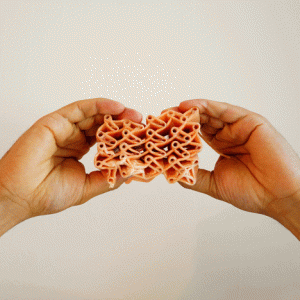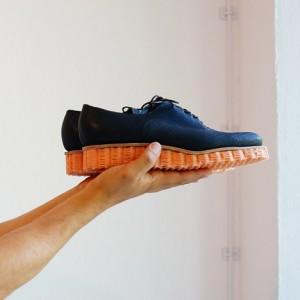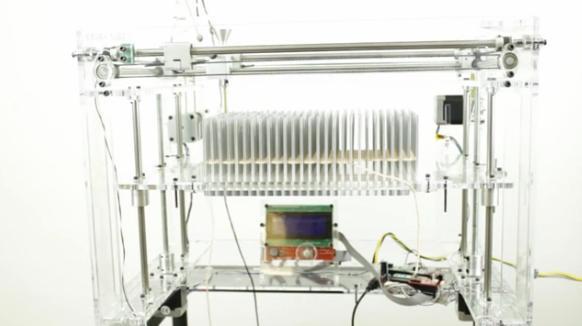We have seen so many amazing applications for 3D printing, but one area lacking within the space is comfortable clothing. Sure, we have seen a tremendous number of 3D printed decorative ornaments, hats, and dresses  worn by models on the runway, however, most of these pieces are rigid and not something you’d comfortably wear in public. The reason is simple, most 3D printers only print in materials which are traditionally hard and rather stiff, using plastics, metals, and resins.
worn by models on the runway, however, most of these pieces are rigid and not something you’d comfortably wear in public. The reason is simple, most 3D printers only print in materials which are traditionally hard and rather stiff, using plastics, metals, and resins.
Earlier this year we were all introduced to the OpenKnit, open source knitting machine. This device was capable of ‘printing’ garments which are very comfortable to wear, but it wasn’t exactly a 3D printer per se, since it only actually prints in one dimension. Then a couple months ago, Disney Research unveiled their 3D felting printer which could in fact make 3D prints using yarn, but from what we saw, the objects could not be very thick. No worries though, because a Royal College of Art (RCA) graduate, named Oluwaseyi Sosanya, has figured out a way to create a 3D weaving machine for his graduate project.
The machine, which works similarly to that of a 3D printer, by the way it moves material in a precise orientation, also has many differences to that of a 3D printer, as you will see in the video at the bottom of this article.
The yarn is fed into two tubes on the weaving machine, and then into a device which you could call an extruder, as it has a similar function to that of a 3D printer extruder. The extruder then wraps the yarn around vertical polls in a specific manner. Like traditional 3D printing, the yarn is layered as it is woven between the polls, creating an actual 3D object.
“I looked at a few different machines when designing this one and got most inspiration from a sewing machine and an industrial knitting machine,” said Sosanya. “Both of these machines allow thread to move freely through the mechanics using springs and guiding to hold the tension. With the 3D Weaver, once the first row is layered, the thread maintains its tension, due to guide tubes and a initial winding of the thread programmed to run before the weaving of each structure. I coded a bit of software that allows any solid geometry to be split into layers and woven.”
Unlike 3D printing, the structures are able to be held together without adhesives, or any melting of the material. For extra structural integrity, Sosanya dips his prints into a silicone liquid, which provides the cloth-like objects with rigidity. For instance he was able to print out the sole for two shoes with a natural fiber, consisting of wool, cotton, and paper. Once dipped into the silicone it exhibits the same basic structure of an ordinary shoe sole
“The reason for using the materials I have chosen was to keep flexibility in the pieces,” the designer told Dezeen. “Their behavior is solely dependent on the structures. Both thread and binder work together to hold the structure. A continuous fiber running though the piece provides more stability with less mass.”
Sosanya’s work is on display at the Royal College of Art Show from now until June 29th. He believes that there could be a number of interesting applications for this patent pending technology, from medical uses to that of construction. Let us know what you think about this 3D weaving machine in the 3D weaving forum thread on 3DPB.com. Check out the video of the machine in action below, as well as some of the woven objects it has created.
[Source: SosaFresh, Dezeen]Subscribe to Our Email Newsletter
Stay up-to-date on all the latest news from the 3D printing industry and receive information and offers from third party vendors.
You May Also Like
Gorilla Sports GE’s First 3D Printed Titanium Cast
How do you help a gorilla with a broken arm? Sounds like the start of a bad joke a zookeeper might tell, but it’s an actual dilemma recently faced by...
Nylon 3D Printed Parts Made More Functional with Coatings & Colors
Parts 3D printed from polyamide (PA, Nylon) 12 using powder bed fusion (PBF) are a mainstay in the additive manufacturing (AM) industry. While post-finishing processes have improved the porosity of...
$25M to Back Sintavia’s Largest Expansion of Metal 3D Printing Capacity Since 2019
Sintavia, the digital manufacturing company specializing in mission-critical parts for strategic sectors, announced a $25 million investment to increase its production capacity, the largest expansion to its operations since 2019....
Velo3D Initiates Public Offering in a Bid to Strengthen Financial Foundations and Drive Future Growth
Velo3D (NYSE: VLD) has been among a number of publicly traded 3D printing firms that have attempted to weather the current macroeconomic climate. After posting a challenging financial report for 2023,...

































